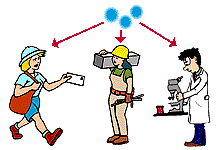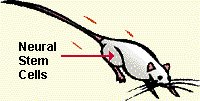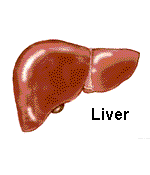 | Stem Cells to the Rescue? |  |
 | Stem Cells to the Rescue? |  |
|
By Ellen Kuwana Neuroscience for Kids Staff Writer April 29, 1999 | An observation about muscle cells in brain tumors sparked research which may one day give researchers vital clues about how cells and identities can be manipulated to fight diseases. |
| "What do you want to be when you grow up?" A firefighter, a
doctor, an architect, a cook, a musician? No matter what you do when you
grow up, you can always change careers and become something else. A cell,
however, once it becomes a heart cell or a muscle cell, cannot change. Or,
so scientists thought! Studies in the past year have shown that some cells can change their fate. For example, one study showed that early brain cells called neural stem cells can act as bone marrow, the reddish substance inside of bones that produces blood cells. Stem cells are undifferentiated - like people seeking a career, these cells do not yet have a specific identity. Signals in the body cause stem cells to go through the process of differentiation to become a certain type of cell, such as a liver cell or a skin cell. |  |
How did researchers think of such a unique experiment?Often in science clues to how things work come from areas seemingly unrelated to what is being studied. In this case, Angelo Vescovi in Italy had been reading about brain tumors that contained muscle cells as well as brain cells. Muscle cells in the brain? Where did these muscle cells come from? Vescovi decided to investigate. |

|

| Vescovi and other scientists demonstrated that neural stem cells could become bone marrow cells.They used mice with bone marrow that had been destroyed by irradiation. Irradiation is used as a treatment for people who have some forms of cancer such as leukemia. The researchers injected the mice with neural stem cells that had been marked so that they could be identified. These cells made themselves at home where the bone marrow used to be and functioned as bone marrow cells to produce new blood cells. This process was described in the journal Science (January 22, 1999).Although this new information that adult cells can change identity simply by being put in a new environment is exciting, it does not mean that all cells can switch identities. It is, however, a promising result because it gives hope for treatments for diseases where bone marrow cells are not functioning properly. This would include many blood disorders and diseases such as leukemia. This is significant because the stem cells in bone marrow that produce blood in your body are difficult to grow in a laboratory. If neural stem cells can do the job of differentiated cells and these stem cells could be produced in the lab, neural stem cells promise to be a feasible therapy. |
The FutureFuture experiments will likely investigate the possibility that non-neural stem cells can transform into other types of cells such as brain cells. This would be a useful step in treating brain disorders such as Parkinson's disease and Alzheimer's disease where brain cells do not function properly.Perhaps one day it will be possible to use the neural stem cells to make not only other cells, but to organize these cells into an organ, such as a liver. At the present time there are not enough donor livers for all of the people in need of liver transplants. If scientists could create a new liver in the laboratory, many lives could be saved. |

|
| References:
|
| BACK TO: | Neuroscience In The News | Table of Contents |
![[email]](./gif/menue.gif) Send E-mail |
 Fill out survey |
 Get Newsletter |
 Search Pages |
 Take Notes |